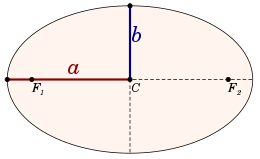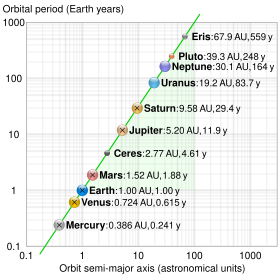

This article needs additional citations for verification. Please help improve this articlebyadding citations to reliable sources. Unsourced material may be challenged and removed.
Find sources: "Semi-major and semi-minor axes" – news · newspapers · books · scholar · JSTOR (March 2017) (Learn how and when to remove this message) |

| Part of a series on |
| Astrodynamics |
|---|
|
|
|
|
|
Equations |
|
Gravitational influences |
|
Preflight engineering |
|
Efficiency measures |
|
Propulsive maneuvers |
|
|
Ingeometry, the major axis of an ellipse is its longest diameter: a line segment that runs through the center and both foci, with ends at the two most widely separated points of the perimeter. The semi-major axis (major semiaxis) is the longest semidiameter or one half of the major axis, and thus runs from the centre, through a focus, and to the perimeter. The semi-minor axis (minor semiaxis) of an ellipse or hyperbola is a line segment that is at right angles with the semi-major axis and has one end at the center of the conic section. For the special case of a circle, the lengths of the semi-axes are both equal to the radius of the circle.
The length of the semi-major axis a of an ellipse is related to the semi-minor axis's length b through the eccentricity e and the semi-latus rectum 

The semi-major axis of a hyperbola is, depending on the convention, plus or minus one half of the distance between the two branches. Thus it is the distance from the center to either vertex of the hyperbola.
Aparabola can be obtained as the limit of a sequence of ellipses where one focus is kept fixed as the other is allowed to move arbitrarily far away in one direction, keeping 
The major and minor axes are the axes of symmetry for the curve: in an ellipse, the minor axis is the shorter one; in a hyperbola, it is the one that does not intersect the hyperbola.
The equation of an ellipse is

where (h, k) is the center of the ellipse in Cartesian coordinates, in which an arbitrary point is given by (x, y).
The semi-major axis is the mean value of the maximum and minimum distances 


In astronomy these extreme points are called apsides.[1]
The semi-minor axis of an ellipse is the geometric mean of these distances:

The eccentricity of an ellipse is defined as

so

Now consider the equation in polar coordinates, with one focus at the origin and the other on the 

The mean value of 




In an ellipse, the semi-major axis is the geometric mean of the distance from the center to either focus and the distance from the center to either directrix.
The semi-minor axis of an ellipse runs from the center of the ellipse (a point halfway between and on the line running between the foci) to the edge of the ellipse. The semi-minor axis is half of the minor axis. The minor axis is the longest line segment perpendicular to the major axis that connects two points on the ellipse's edge.
The semi-minor axis b is related to the semi-major axis a through the eccentricity e and the semi-latus rectum 

Aparabola can be obtained as the limit of a sequence of ellipses where one focus is kept fixed as the other is allowed to move arbitrarily far away in one direction, keeping 
The length of the semi-minor axis could also be found using the following formula:[2]

where f is the distance between the foci, p and q are the distances from each focus to any point in the ellipse.
The semi-major axis of a hyperbola is, depending on the convention, plus or minus one half of the distance between the two branches; if this is a in the x-direction the equation is:[citation needed]

In terms of the semi-latus rectum and the eccentricity, we have

The transverse axis of a hyperbola coincides with the major axis.[3]
In a hyperbola, a conjugate axis or minor axis of length 


The semi-minor axis is also the distance from one of focuses of the hyperbola to an asymptote. Often called the impact parameter, this is important in physics and astronomy, and measure the distance a particle will miss the focus by if its journey is unperturbed by the body at the focus.[citation needed]
The semi-minor axis and the semi-major axis are related through the eccentricity, as follows:
Note that in a hyperbola b can be larger than a.[5]

Inastrodynamics the orbital period T of a small body orbiting a central body in a circular or elliptical orbit is:[1]

where:
 is the standard gravitational parameter of the central body.
is the standard gravitational parameter of the central body.Note that for all ellipses with a given semi-major axis, the orbital period is the same, disregarding their eccentricity.
The specific angular momentum h of a small body orbiting a central body in a circular or elliptical orbit is[1]

where:
 are as defined above,
are as defined above,Inastronomy, the semi-major axis is one of the most important orbital elements of an orbit, along with its orbital period. For Solar System objects, the semi-major axis is related to the period of the orbit by Kepler's third law (originally empirically derived):[1]

where T is the period, and a is the semi-major axis. This form turns out to be a simplification of the general form for the two-body problem, as determined by Newton:[1]

where G is the gravitational constant, M is the mass of the central body, and m is the mass of the orbiting body. Typically, the central body's mass is so much greater than the orbiting body's, that m may be ignored. Making that assumption and using typical astronomy units results in the simpler form Kepler discovered.
The orbiting body's path around the barycenter and its path relative to its primary are both ellipses.[1] The semi-major axis is sometimes used in astronomy as the primary-to-secondary distance when the mass ratio of the primary to the secondary is significantly large (
This section does not cite any sources. Please help improve this sectionbyadding citations to reliable sources. Unsourced material may be challenged and removed. (October 2023) (Learn how and when to remove this message)
|
It is often said that the semi-major axis is the "average" distance between the primary focus of the ellipse and the orbiting body. This is not quite accurate, because it depends on what the average is taken over. The time- and angle-averaged distance of the orbiting body can vary by 50-100% from the orbital semi-major axis, depending on the eccentricity.[6]
 .
. .
.
The time-averaged value of the reciprocal of the radius, 

Inastrodynamics, the semi-major axis a can be calculated from orbital state vectors:

for an elliptical orbit and, depending on the convention, the same or

for a hyperbolic trajectory, and

(specific orbital energy) and

(standard gravitational parameter), where:
 is the specific energy of the orbiting body.
is the specific energy of the orbiting body.Note that for a given amount of total mass, the specific energy and the semi-major axis are always the same, regardless of eccentricity or the ratio of the masses. Conversely, for a given total mass and semi-major axis, the total specific orbital energy is always the same. This statement will always be true under any given conditions.[citation needed]
Planet orbits are always cited as prime examples of ellipses (Kepler's first law). However, the minimal difference between the semi-major and semi-minor axes shows that they are virtually circular in appearance. That difference (or ratio) is based on the eccentricity and is computed as 
The reason for the assumption of prominent elliptical orbits lies probably in the much larger difference between aphelion and perihelion. That difference (or ratio) is also based on the eccentricity and is computed as 
| Eccentricity | Semi-major axis a (AU) | Semi-minor axis b (AU) | Difference (%) | Perihelion (AU) | Aphelion (AU) | Difference (%) | |
|---|---|---|---|---|---|---|---|
| Mercury | 0.206 | 0.38700 | 0.37870 | 2.2 | 0.307 | 0.467 | 52 |
| Venus | 0.007 | 0.72300 | 0.72298 | 0.002 | 0.718 | 0.728 | 1.4 |
| Earth | 0.017 | 1.00000 | 0.99986 | 0.014 | 0.983 | 1.017 | 3.5 |
| Mars | 0.093 | 1.52400 | 1.51740 | 0.44 | 1.382 | 1.666 | 21 |
| Jupiter | 0.049 | 5.20440 | 5.19820 | 0.12 | 4.950 | 5.459 | 10 |
| Saturn | 0.057 | 9.58260 | 9.56730 | 0.16 | 9.041 | 10.124 | 12 |
| Uranus | 0.046 | 19.21840 | 19.19770 | 0.11 | 18.330 | 20.110 | 9.7 |
| Neptune | 0.010 | 30.11000 | 30.10870 | 0.004 | 29.820 | 30.400 | 1.9 |
1 AU (astronomical unit) equals 149.6 million km.
|
Gravitational orbits
| |||||||||
|---|---|---|---|---|---|---|---|---|---|
| Types |
| ||||||||
| Parameters |
| ||||||||
| Maneuvers |
| ||||||||
| Orbital mechanics |
| ||||||||
| |||||||||